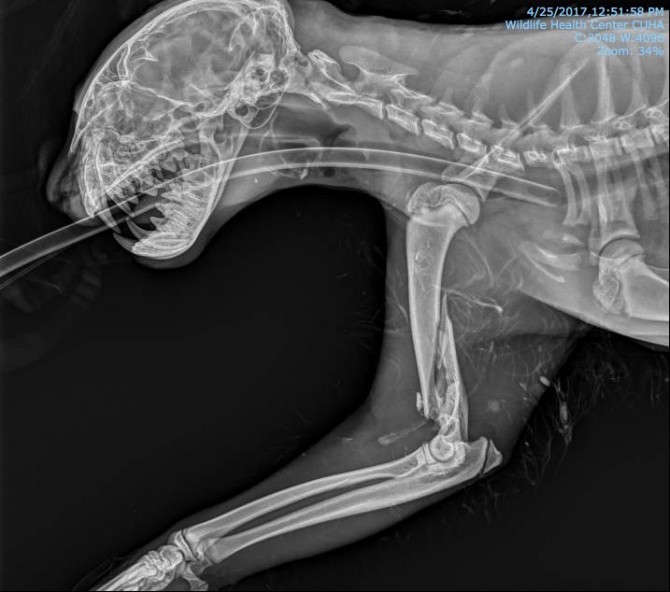
Dr. Christina McCullough, left, and Dr. Sara Childs-Sanford prepare a young bobcat for examination.
Veterinary college mends, releases injured bobcat
By Melissa Osgood
In April, Cornell’s Janet L. Swanson Wildlife Health Center (WHC) admitted a young male bobcat after he was hit by a car in Lansing, New York.
After receiving a call from a witness to the accident, WHC wildlife veterinarians worked with officers from the New York State Department of Environmental Conservation and a nuisance wildlife control operator to capture and transport the bobcat to WHC.
When he arrived, the bobcat was in critical condition and required several days of care to stabilize his condition and allow bleeding in his lungs to resolve. He was also diagnosed with a severely fractured humerus (a bone in the forelimb) and a hip that had been moved far out of the joint.
Dr. Ursula Krotscheck, chief of small animal surgery at the Cornell University Hospital for Animals, evaluated the bobcat and radiographs of his forelimb fracture. The bone was fragmented into numerous pieces, and she determined that a metal plate was necessary to bring together the pieces and give the bobcat the best chance of healing.
Donating time, equipment and expertise to WHC, Krotscheck spent several hours performing the grueling procedure, challenged by anatomy that was different from her domestic patients and by a fracture that was extremely difficult to repair. After a few days of recuperation, the bobcat underwent another surgical procedure by Krotscheck, in which his severely dislocated hip was addressed. WHC veterinarians continued to provide the bobcat with care and aggressive pain control for the next several days, until the rehabilitation phase of his care could begin.
The bobcat was transferred to licensed wildlife rehabilitator Cindy Page, who housed the bobcat in a small area at first to restrict his activity and allow the bones to heal. He was given privacy but remained secretive, wary of humans and aggressive when approached. After approximately 10 weeks of rest and healing, he was returned to WHC for a checkup.
The results of the radiographs were stunning: a beautifully healed fracture with perfect alignment. An exam showed good range of motion of the injured hip as well. He had grown, gained weight and was in excellent condition. As he recovered from anesthesia in a large dog crate, his release plans were solidified for the following day.
With assistance from Todd Bittner, director of natural areas for Cornell Botanic Gardens, a large area near his original home range was chosen. At noon on Friday, July 28, the door of his crate was opened, facing onto a beautiful sunny meadow, while all of those involved in the bobcat’s care silently looked on.
Among the onlookers were many people involved with his recovery – a representation of the steps and stages native wildlife such as the bobcat must go through when ill or injured. Despite the open door, the bobcat hunkered down toward the back of the carrier, apprehensive and unsure. With some coaxing and gentle tipping of the carrier forward, he finally made a break for it – shooting out of the carrier across the meadow toward a dense forest.
Melissa Osgood is assistant director of media relations and leadership communication at the College of Veterinary Medicine.
Media Contact
Get Cornell news delivered right to your inbox.
Subscribe